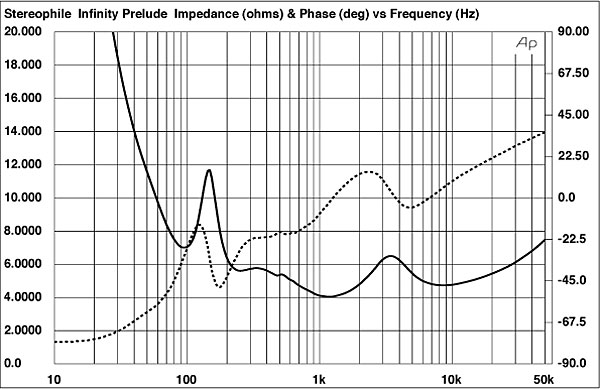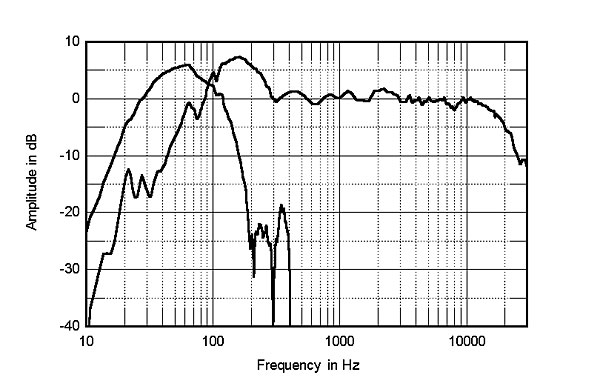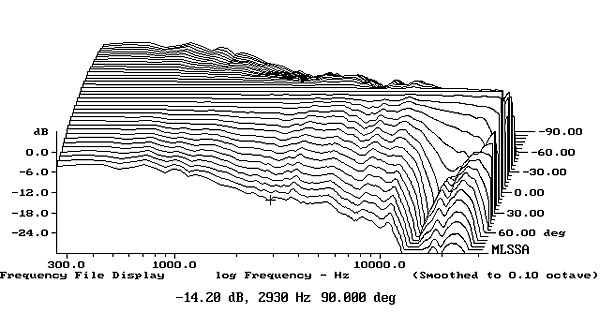| Columns Retired Columns & Blogs |
Infinity Composition Prelude P-FR loudspeaker Measurements
Sidebar 2: Measurements
JA performed the measurements, supplying me with the results after I had finished my auditioning. The Prelude's B-weighted sensitivity measured 95.5dB—slightly lower than the claimed 96dB figure. Still, 95.5dB is an amazingly high sensitivity, particularly for a loudspeaker as flat in response as the Prelude (as we'll see later). Looking at the impedance-magnitude and phase-angle plots (fig.1), we can see that the Prelude's impedance is closer to 5 ohms nominal than the specified 6 ohms nominal. The impedance dips to 4 ohms (at 1.2kHz) and is less than 6 ohms across most of the band.

Fig.1 Infinity Composition Prelude P-FR, electrical impedance (solid) and phase (dashed) (2 ohms/vertical div.).
The rapidly rising impedance below 100Hz, accompanied by the negative (capacitive) phase angle, is caused by the series capacitor that forms the high-pass filter on the midrange/tweeter column (the woofer is self-powered). The impedance peak at 150Hz is the midrange/tweeter column's tuning. A slight wrinkle in the impedance-magnitude plot just above 500Hz could be caused by a cabinet resonance. JA, who performed the measurements on the Prelude, noted cabinet resonances at 120Hz, 155Hz, 200Hz, and strong vibrations at 305Hz and 530Hz. I didn't find any of these resonances to produce audible coloration, however.
Although the 5 ohm nominal impedance suggests that the Prelude is a more difficult load for an amplifier than I had guessed from the auditioning, the benign phase angle makes the speaker look more resistive than reactive through most of the band—a benefit for single-ended tubed amplifiers. Moreover, the impedance is fairly constant with frequency, which reduces impedance interactions when driving the Prelude with a high-output-impedance amplifier such as the Cary CAD-300SEI. Amplifiers with low output impedances won't exhibit these frequency-response deviations. Overall, the Prelude is, on paper, a little more difficult to drive than I would have guessed from my experience with the 11W 300SEI. Its extraordinarily high sensitivity and powered woofer no doubt make up for the lowish impedance.
Fig.2 is the Prelude's frequency response measured on the tweeter axis and averaged over a 30° window. The most striking aspect of this curve is the astonishingly flat response through the midband and treble. Loudspeakers don't come any flatter than this. The apparent peak between 100Hz and 300Hz may be a measurement artifact. When JA made the measurements, he calculated the overall nearfield LF response by combining the outputs of the four drive-units and eight ports reproducing much the same signal. He doesn't swear, therefore, that the upper-bass peak in the measurement is real. I suspect this is the case, both from my auditioning (if anything, the speaker sounded lean between 100Hz and 300Hz) and from Infinity's specification of 35Hz–20kHz ±2dB.

Fig.2 Infinity Composition Prelude P-FR, anechoic response on tweeter axis at 50", averaged across 30° horizontal window and corrected for microphone response, with complex sum of nearfield woofer and port responses plotted below 300Hz, and nearfield active woofer response plotted below 400Hz (top at 50Hz).
The woofer response in fig.2 confirms the specified $*–6dB point of 25Hz. We can see the woofer breakup modes (the peaks at 250Hz and 350Hz), but this occurs well beyond the woofer's passband. Finally, the woofer rolls off very rapidly (30dB/octave), probably to get it well-attenuated before the breakup modes.
The other interesting feature of fig.2 is the top-octave rolloff of nearly 5dB at 20kHz. I noted in the auditioning that the Prelude tended to have a smaller, more tightly defined soundstage rather than a huge, billowy presentation. A top-octave rolloff tends to reduce a loudspeaker's sense of "air" and extension rather than affect the tonal balance. The "brightness" region is not in the top octave but in the two lower octaves (2.5kHz–5kHz and 5kHz–10kHz). Note, however, that this measurement was made by averaging the response over a 30° horizontal window. The measured on-axis response was flatter above 10kHz. The Prelude's measured response correlated closely with the listening impressions—particularly the even octave-to-octave balance, extraordinarily flat midband and treble, and slightly rolled-off top octave.
For comparison, fig.3 is the measured response across a 30° lateral window of the P-CC center-channel speaker derived from the P-FR. Very similar to the response of the P-FR, the P-CC lacks a little bit of energy in the presence region due to the off-axis contribution to this curve. On the tweeter axis, the P-CC measured as flat as the P-FR.

Fig.3 Infinity Composition Prelude P-CC, anechoic response on tweeter axis at 50", averaged across 30° horizontal window and corrected for microphone response, with complex sum of nearfield woofer and midrange responses plotted below 300Hz. The nearfield responses of the midrange units and woofers are also shown.
Fig.4 is the Prelude's horizontal response family, which shows how the loudspeaker's response changes off-axis. The straight line is the normalized on-axis response—it does not represent the P-FR's actual response [though it comes close—Ed.]. The other curves in fig.4 show just the deviation from the on-axis response. The Prelude's narrow baffle naturally confers excellent dispersion, as seen in the flatness of the off-axis curves. Past 10° or so off-axis, however, the response drops rapidly above 10kHz, largely due to the "elliptical waveguide" molded into the baffle around the tweeter. (This limited top-octave dispersion made its presence known in fig.2, which was an average of the Prelude's response over a 30° window, by contributing to the apparent rolloff above 10kHz.) Again, this behavior corresponds to my impression of a polite treble and lack of air, particularly when the Prelude was driven by the 300SEI (which has its own treble rolloff).

Fig.4 Infinity Composition Prelude P-FR, horizontal response family at 50", normalized to response on tweeter axis, from back to front: differences in response 90°–5° off-axis; reference response; differences in response 5°–90° off-axis.
The vertical response family (fig.5) shows virtually no change in tonal balance as a function of listening height between the P-FR's two midrange units. You can sit in any normal-height listening seat and the sound will be the same. [Sit too high or too low, however, and suckouts appear, due to the use of spaced drive-units handling the same frequency ranges.—Ed.]

Fig.5 Infinity Composition Prelude P-FR, vertical response family at 50", normalized to response on tweeter axis, from back to front: differences in response 15°–5° above axis; reference response; differences in response 5°–15° below axis.
Turning next to the time domain, fig.6 is the Prelude's impulse response measured on the tweeter axis. The system is obviously not time-coherent, although the midrange and tweeter are connected with the same polarity. The more illustrative step response (fig.7) shows the tweeter (the first negative-going spike) followed by the upper-midrange drivers (the second negative-going spike), and finally the woofer and lower-midrange drivers (the large, positive-going hump).

Fig.6 Infinity Composition Prelude P-FR, impulse response on tweeter axis at 50" (5ms time window, 30kHz bandwidth).

Fig.7 Infinity Composition Prelude P-FR, step response on tweeter axis at 50" (5ms time window, 30kHz bandwidth).
Fig.8 shows the Prelude's cumulative spectral-decay, or waterfall, plot, uncorrected for the measurement microphone's 15kHz peak. The decay is fast and clean, which correlates with good resolution of detail and transient response. There is some delayed resonant energy present at 3550Hz, but this is very minor. Overall, the Prelude's waterfall plot is superb. The P-CC speaker's waterfall behavior was similarly excellent.

Fig.8 Infinity Composition Prelude P-FR, cumulative spectral-decay plot at 50" (0.15ms risetime).
In addition to sounding great, the Prelude had excellent measured performance—particularly its flat on-axis response and outstandingly clean waterfall plot.—Robert Harley
- Log in or register to post comments




































